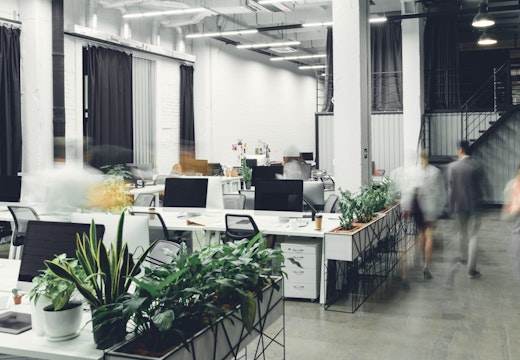How space optimisation can create sustainable and happy offices
What’s the endgame in optimising your office space? The third in our article series with Deskbird explores how space optimisation can support the green agenda and promote productivity
Space optimisation strategies have the power to transform both your physical office and the experience of your employees, as we have discussed in this article series with Deskbird. Implementing these practices not only increases efficiency but also caters to the needs of employees. Understanding what types of workspaces and resources are needed plays a crucial role in the productivity and emotional wellbeing of your team.
Collecting occupancy data is the perfect place to start when optimising your workspace. By leveraging technology and data, leaders can understand how the office is being used in order to make informed decisions about repurposing the workplace. Such decisions also contribute to cost savings and sustainability, the latter being an important value for many of us.
Space optimisation also aids implementing flexible work models, which inherently lend themselves to sustainability, as fewer resources are consumed and emissions from commuting are reduced.
What is space optimisation?
Space optimisation is a term that describes the practice of transforming and fitting office space to be more efficient and meet the needs of employees. Understanding your office contributes to cost savings, sustainability and happier, more productive employees. These benefits are highly integrated, as saving on energy often means also decreasing costs. And, studies have shown that satisfied employees are more dedicated and efficient.
First, to optimise office space, business leaders must understand employees’ diverse requirements, such as space for focus, collaboration, and relaxation. Once these needs are outlined, facility and CRE managers can adjust the space to align with what their team requires.
Next, occupancy data should be collected to get an overview of how many people are actually coming into the building and which spaces they are using more. This has become increasingly important in a world where flexible and hybrid work models are becoming commonplace.
Occupancy and utilisation can be tracked through week planning and hot desking systems, allowing leaders to make confident, data-based decisions about downsizing or repurposing the existing workspace. Such technology is indispensable as office usage fluctuates by the time of day and week, especially in our modern, flexible work environment.
Be sure to explore the first two articles in this series in collaboration with Deskbird for a deeper dive into the meaning of space optimisation and how it can specifically lower office costs.
How to drive sustainability
In the world of flexible work, there are many opportunities to improve the environmental sustainability of your workplace. These initiatives are extremely important, not only for the planet but also for the growing millennial and gen-Z population in the workforce. Sustainability is a core value for these two groups, guiding their decision-making and attitudes toward organisations.
Many younger workers search for companies that match their own values, making sustainability a priority for organisations that want to attract and recruit fresh talent. Luckily, flexible models tend to be more sustainable and their popularity has grown simultaneously with the importance of environmental consciousness. With hybrid and remote models, fewer employees are coming into the office daily, meaning that fewer resources are being used.
‘Many younger workers search for companies that match their own values…’
Downsizing office space also becomes possible which requires less energy to power. Additionally, less time spent in the office means less commuting, reducing emissions from transport.
However, coordinated hybrid models, those that are optimised through technology, reach these goals even more quickly and efficiently. Space optimisation allows companies to adjust the amount of space they need based on occupancy data, which will fluctuate depending on how often employees come into the office. These adjustments can greatly improve sustainability as they will allow for downsizing, helping to reduce energy consumption. Similarly, the data will help facility managers to understand space utilisation, turning off the power to rooms or areas that are not in use.
Improving employee experience
Employee experience is often guided by the physical office environment. Not only do factors such as lighting and open space impact employee productivity and emotional wellbeing, but so do the actual organisation of desks, meeting rooms and resources. In flexible environments, it is important for employees to know when colleagues are in the office.
In the post-pandemic world, many people miss meeting with colleagues in person, not only for the benefits of collaboration but also to form genuine friendships and connections. Both of these have a massive impact on employee happiness and productivity.
Therefore, optimised offices use week planning apps to give employees an overview of who is in the office and when, so that teammates can coordinate with days they will meet in person. Additionally, workplace technology ensures meeting rooms and desks are available so that both collaborative and quiet spaces are unoccupied when needed. The last thing you want is for an employee to commute to the office just to find there is no space for them to work. That builds frustration and not only harms the employee experience but also discourages people from coming to the office.
Similarly, space optimisation also helps inform the distribution of resources. For example, how many desktop computers are being used? Are employees bringing in their own devices? Answers to these questions are important for IT teams setting up resources in the office. It is also helpful for facility managers to know what employees require when coming in.
A powerful framework
Space optimisation offers a powerful framework for creating environmentally friendly and happy offices. By understanding employee needs, collecting occupancy data, and leveraging technology, organisations can garner a range of benefits from cost savings to sustainability.
In today’s work landscape, where flexible and hybrid models have gained traction, space optimisation becomes even more crucial. It allows businesses to adapt to changing workforce dynamics and align with the values of younger generations entering the workforce. Furthermore, by optimising the physical office environment and implementing the right technology, companies can foster collaboration, improve productivity, and create a positive and engaging workplace culture.








